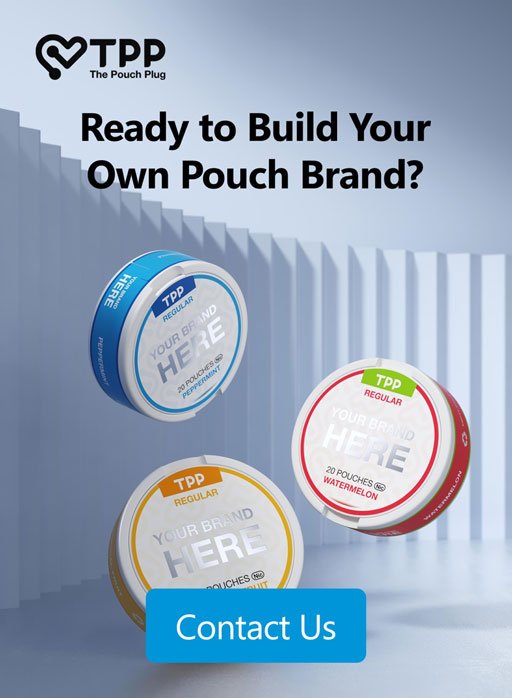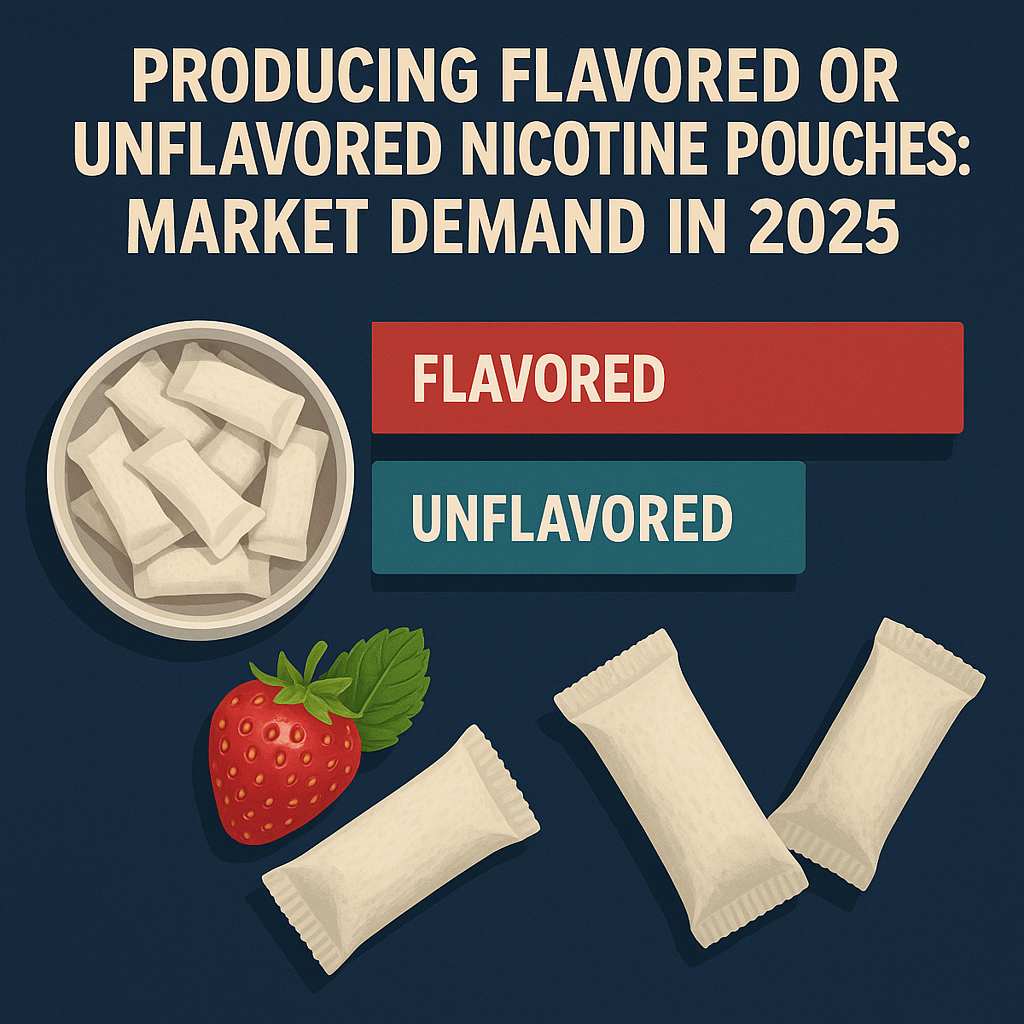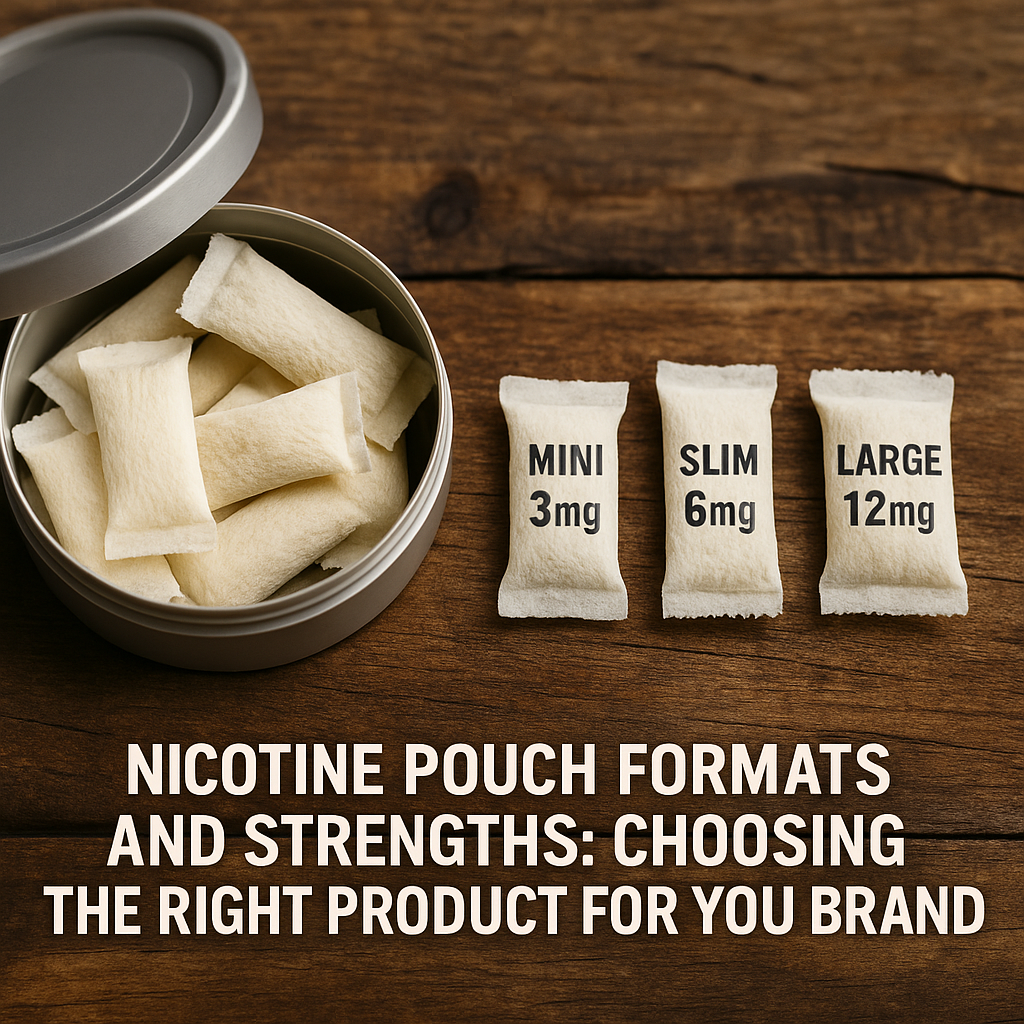Launching a new nicotine pouch brand is exciting – and potentially lucrative. For example, the global nicotine pouch market was estimated at USD 5.39 billion in 2024 (and is expected to grow around 30% annually) grandviewresearch.com. However, the nicotine pouch market has exploded recently (sales grew over 300× in the U.S. between 2016 and 2021 grandviewresearch.com), which means competition is fierce. Whether you’re launching a nicotine pouch brand or starting a nicotine pouch company, it’s easy to make critical mistakes early on. In this article, we’ll walk through the top 10 pitfalls to avoid – from overlooking regulations and market research to skimping on quality and branding.
Mistake 1: Skipping Market Research and Consumer Insight

A top mistake is underestimating your market. New nicotine pouch brands often fail to research their customers and competitors. Without data on consumer preferences and trends, you may misjudge demand. For example, some startups assume any flavor or nicotine level will sell, only to find limited interest in certain formats. In fact, nicotine pouch sales have surged as customers seek new flavors and strengths truthinitiative.org.
- Ignoring demand trends. Failing to analyze market data or online search trends can lead to launching products that consumers don’t want. Use tools like keyword planners or industry reports (e.g. Grandview Research) to gauge interest in different flavors or pouch styles.
- Not studying competitors. The big players like ZYN, Velo, and ON! have already shaped consumer tastes truthinitiative.orgtruthinitiative.org. Understand what flavors and formats are popular. Don’t just imitate – find gaps. For instance, if everyone offers mint and wintergreen, maybe a new fruit or unique herbal flavor could stand out.
- Overlooking target audience. Define your ideal customer (age, lifestyle, usage occasions). Younger users may prefer trendy packaging and social-media appeal, while older consumers might favor discreet, tobacco-like options. Tailoring products to your audience prevents wasted inventory.
Tip: Conduct quick surveys or use social listening to hear what actual users say. This can catch changes fast.
Mistake 2: Overlooking Local Rules and Product Requirements
When launching a nicotine pouch brand, it’s easy to get caught up in product design and branding—but forgetting about market-specific requirements can lead to serious issues. Different countries (and even regions within a country) may have their own rules regarding ingredients, packaging, and what products are allowed to be sold.
Here are a few important things to consider early:
- Every market has its own rules. While nicotine pouches are legal in many regions, the details often vary—like what flavors are allowed, what must be included on the label, or whether there are nicotine strength caps.
- Packaging expectations. In many areas, products with nicotine are expected to include age warnings, ingredient lists, and child-resistant packaging.
- Clear labeling helps build trust. Even if your pouches are tobacco-free, it’s still important to list nicotine content and offer transparent product info so that users know exactly what they’re getting.
🛠️ Pro tip: Before launching in a new region, do your homework. Check what top competitors are doing in that market, and make sure your packaging, flavor offering, and labeling meet the general expectations there.
Staying informed will help you avoid product delays, negative feedback, or changes after launch. While the legal side can vary by market, being proactive about these details helps protect your brand and makes expansion easier in the long run.
Mistake 3: Choosing the Wrong Manufacturer or Partner
Your choice of manufacturing partner can make or break your brand. Many entrepreneurs pick the cheapest factory or go with one that lacks experience in pouch products. That’s a recipe for trouble. When you’re starting a nicotine pouch company, look for an OEM/ODM partner that ticks these boxes:
- Full-Service OEM/ODM solutions. A reliable partner like The Pouch Plug offers both OEM and ODM nicotine pouch manufacturing services (see our OEM/ODM page). They can help formulate unique flavors and adjust nicotine levels per your specs. Don’t settle for limited options; customization is key.
- Quality Controls. Poor hygiene or inconsistent mixing can lead to product failures or recalls. For instance, The Pouch Plug emphasizes the importance of quality by following production standards rooted in over 12 years of Swedish nicotine pouch expertise—known globally for precision, cleanliness, and consistency. .
- Proven track record. A partner with experience in the nicotine pouch industry understands the nuances of blending and. Ask for references or look for testimonials.
⚙️ Subpoint: Understand OEM vs. ODM. OEM (you provide the formula/packaging design) vs. ODM (factory creates formula/design) models offer different levels of flexibility. Choose the one that suits your expertise and resources. For turnkey solutions, an OEM/ODM manufacturer can save time and help avoid costly trial-and-error.
Working closely with a skilled factory means smoother product development and faster turnaround. For guidance on the production process itself, see our nicotine pouch manufacturing overview, which covers the steps from raw materials to finished cans.
Mistake 4: Neglecting Product Variety (Flavors, Strengths, and Formats)

One size does not fit all in the nicotine pouch market. A common error is launching with only a single flavor or strength. Successful brands know customers crave choice. Consider these subpoints:
- Too few flavors or strengths. If you start with just “Spearmint, 6mg,” many customers will feel left out. Offering multiple nicotine strengths (e.g. 4mg, 8mg, 12mg) covers both casual and heavy users. Likewise, include a range of flavors: mint, citrus, coffee, berry, etc. Industry guides show that varieties in pouch format and nicotine level greatly influence user experience (see our Formats & Strengths guide to decide which options fit your market).
- Ignoring format preferences. Nicotine pouches come in slim or regular sizes, white (dry) or original (moist), mini or full portion. Users can be very particular about texture and portion size. If you only offer one format, you may miss your ideal segment.
- Lack of innovation. Watch trends like flavored or sugar-free variants. Some consumers seek novel formulations (e.g. caffeine + nicotine, herbal blends). R&D can give you an edge.
Offer samples or test batches to friends or focus groups before full launch. Use their feedback to refine the line-up. The goal is to match what real consumers want, not just what sounds trendy on paper
Mistake 5: Skimping on Branding and Marketing
Even the best pouch won’t sell if nobody recognizes your brand. Unfortunately, some new companies give branding short shrift. Here are key points:
- Weak brand identity. A nicotine pouch brand needs a strong name, logo, and story. Think beyond generic terms. What image do you want – premium and sleek, or fun and youthful? Inconsistent messaging will confuse customers.
- Poor online presence. Your website and social media should reflect your brand’s personality. Neglecting digital marketing is a missed opportunity: younger pouch users often discover brands via Instagram or TikTok. Consider collaborating with influencers (responsibly) to build credibility.
- No marketing plan. It’s a mistake not to budget for advertising or promotions. Whether it’s SEO, influencer partnerships, or retail demos, you need a plan to raise awareness. Remember, consumers must be convinced to switch from established brands.
📈 Note: Nicotine pouch ads often focus on flavor and freedom of usetruthinitiative.org. Don’t just copy them – craft a unique message. Emphasize natural ingredients, innovative packaging, or community engagement if that fits your audience. Whatever your message, be consistent across all channels.
Mistake 6: Overlooking Packaging Design and Labeling
Good products deserve great packaging. Common mistakes here include:
- Non-compliant labeling. Many countries require child-resistant and tamper-evident packaging for nicotine products. They often mandate health warnings and ingredient lists. If your label is missing this info, it could be illegal to sell. Work with a designer familiar with these rules or consult regulatory guidance when designing cans.
- Poor shelf appeal. Your pouch can should stand out on shelves or in online images. A bland design may be ignored. Use bold colors and clear logos, but balance it with the regulatory text. For inspiration, check out successful brands (like ZYN’s minimalist style or more graphic approaches for younger audiences).
- Ignoring practical features. Details matter: do the lids close snugly? Is the tin durable for pockets? Poor usability (tins that break, labels that peel) can ruin user experience.
🛡️ Pro Tip: Ask your manufacturer about available packaging options. Many offer custom tins or eco-friendly materials. High-quality packaging conveys professionalism and helps justify your pricing.
Mistake 7: Lacking a Strong Distribution and Sales Strategy

Once your product is ready, how will it get to customers? Many startups underestimate the work of distribution:
- No retail partnerships lined up. Big retail channels are crowded. You’ll need to target specific outlets (smoke shops, vape stores, convenience stores, even liquor stores in some regions). Reach out early and have product samples and compliance documents ready. Without distribution channels, even the best product collects dust.
- Ignoring e-commerce. Online sales are huge in this space. Make sure your website is easy to order from, and consider platforms like Amazon (where legal). Offer direct-to-consumer subscriptions for loyal buyers. Neglecting online sales means leaving money on the table.
- Poor pricing strategy. Set pricing by researching competitors and costs. If you price too low, retailers may doubt brand quality; too high, and you scare off trial. Factor in taxes and logistics in your margin calculations.
Remember: “build it and they will come” does not apply. Proactively plan your launch channels, and have promotional support (discount codes, samples) to motivate early adopters.
Mistake 8: Inadequate Quality Control and Testing
Quality issues are a quick way to tank your brand. Imagine customers getting a stale batch or an inconsistent nicotine hit. This erodes trust and invites complaints. Key actions:
- Skip testing at your peril. Always verify nicotine content, pH levels, moisture, and absence of contaminants. Skipping lab tests to save money can lead to failed batches. A reputable factory will test every lot.
- Ensuring consistency across batches. This is crucial. For example, The Pouch Plug’s facilities produce millions of cans monthly with uniform qualityoemnicotine.com. If your supplier can’t guarantee consistent output, find one who can.
- Be wary of cheap ingredients. Off-shore or unverified suppliers might cut costs on filler or flavors. Insist on high-quality fillers (cellulose, fibers) and pharmaceutical-grade nicotine. Even if it raises cost, inferior inputs will hurt your reputation.
🧪 Pro Tip: During development, order multiple small batches and test them yourself or with friends. Check for any defects or variations. Quality should never be an afterthought.
Mistake 9: Financial Missteps and Mispricing
Many new brands miscalculate finances. A few pitfalls to avoid:
- Underestimating startup costs. For example, beyond manufacturing, budget for lab testing, legal fees, packaging design, marketing campaigns, trade shows, and compliance. These can add up fast. Running out of funds mid-launch can halt everything.
- Ignoring payment terms. Additionally, factories often require deposits or payment on delivery. Plan cash flow accordingly. Some companies face delays because they can’t pay for raw materials upfront.
- Poor pricing. Also, as mentioned, don’t just base retail price on cost-plus. Research competitor pricing in your region. Factor in taxes (tobacco levies can be high). Use a cost calculator tool or consult with your contract manufacturer for guidance.
Aim to break even within a reasonable timeframe but also remain competitive. Keep detailed records and revisit budgets regularly.
Mistake 10: Overlooking Legal and Intellectual Property Issues

Lastly, don’t forget the legal basics:
- No trademark. If you don’t trademark your brand and product names, a larger company might beat you to it, forcing a costly rebrand. Even if you start small, secure your domain name and register your trademark early.
- Ignoring patents or licensing. Check whether any unique pouch technologies (like special fibers or flavor-release methods) are patented. If so, you may need licenses. Or better, consider patenting any innovations of your own.
- Not setting up the right business entity. Launch under a proper company structure (LLC, corporation, etc.) to protect personal assets. Consult a lawyer or business advisor.
While branding and manufacturing are in focus, the legal foundation protects your hard work. A small investment now can save huge headaches later.
Conclusion and Your Next Steps

Launching a nicotine pouch brand can be hugely rewarding, but avoiding mistakes is key. To recap, don’t skip thorough market research, understand the regulatory environment, and pick a manufacturing partner you trust. Offer the right mix of flavors, strengths, and formats, and invest in a distinctive brand and quality packaging. Have a clear sales and marketing plan, and always keep control of costs and quality.
Ultimately, partnering with experienced specialists helps. For example, The Pouch Plug’s OEM/ODM solutions can guide you through formula creation and full-scale manufacturing. Our team knows how to produce high-quality pouches on time. Contact The Pouch Plug today to learn how we can streamline your product launch.
FAQ
Q: How do I start a nicotine pouch company?
A: To start a nicotine pouch brand, first research the market and legal requirements. You’ll need a manufacturer to produce the pouches and a plan for packaging, branding, and distribution. Consult experts or guides (like our step-by-step blog), ensure all FDA or local approvals are secured, and develop a strong marketing strategy. Choosing a reputable OEM/ODM partner early can simplify the process.
Q: What regulations affect nicotine pouch brands?
A: Regulations vary by region. In the U.S., nicotine pouches are regulated by the FDA as “tobacco products,” even if they contain synthetic nicotine (fda.gov). Manufacturers must submit applications, use child-resistant packaging, and include health warnings. Some places (like New York) may ban flavors (nysenate.go). Always check the latest rules in your target market.
Q: How many flavors and strengths should I offer?
A: It depends on your audience, but offering variety is important. Many successful brands launch with at least 3–5 flavors (e.g., mint, citrus, berries) and multiple nicotine levels (e.g., 6mg, 12mg, 18mg). Refer to the Formats & Strengths guide to decide which options fit your market.
Q: Why partner with The Pouch Plug for manufacturing?
A: The Pouch Plug specializes in nicotine pouch production with over a decade of experience. We offer turnkey solutions (OEM/ODM) with strict quality controls and fast turnaround. Whether you have a formula or need help developing one, our factories can produce premium pouches at scale. Learn more on our Nicotine Pouch Manufacturing page or contact us directly.
Q: Are nicotine pouches addictive?
A: Yes, nicotine pouches contain nicotine, which is addictive. They should only be used by adults who want nicotine. Brands often highlight that pouches are “tobacco-free” (no-leaf tobacco), but that doesn’t change the nicotine content. Inform users responsibly and comply with all age-restriction laws.











